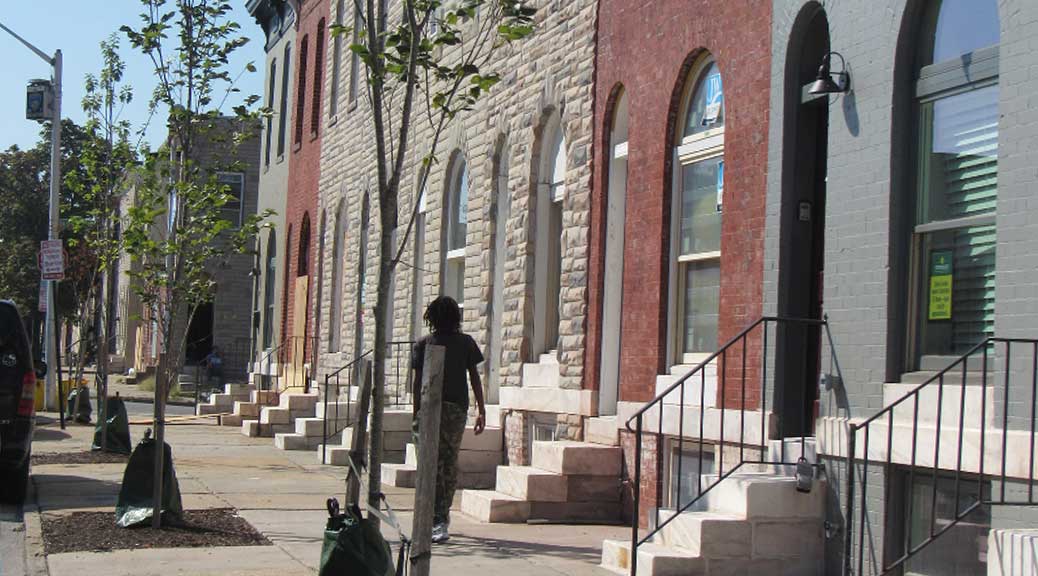The staff of Historic East Baltimore Community Action Coalition, Inc. (HEBCAC) didn’t want the name of their new neighborhood – Station East – to merely make prospective buyers smile.
“Trust me, we laughed through that entire conversation,” remembered Edward Sabatino, executive director of HEBCAC, “but it turned out to be a good name.”
With the success of the Station North arts and entertainment district in mind, the group abandoned subtlety to select an obviously similar moniker for their project, which encompasses the area roughly outlined by Patterson Park Ave. and Rose St. to the east and west, and Eager St. and Ashland Ave. to the north and south.
“Technically, there is some accuracy to the name,” Sabatino said, noting that a MARC train station is planned for the neighboring East Baltimore Development Inc. project, “but it was a bit of tongue-in-cheek, to be honest.”
A similarly lighthearted, “why not?” optimism may well circulate among the present and future residents of Station East, who will enjoy the amenities of the EBDI project as well as Northeast Market, the Monument Street Shopping District, the Patterson Park Branch of the Enoch Pratt Free Library and several parks and green spaces.
Located in an area that could be called “transitional” or “up and coming,” depending on the goals of the describer, the two- to three-bedroom rowhomes are eminently affordable, especially considering the multiple home-buyer incentives available.
Predictably, the neighborhood has attracted much attention from employees of Johns Hopkins Hospital, eager to reap the benefits of their employer’s generous Live Near Your Work incentive, for which they can qualify through home-buying counseling available at the Southeast Community Development Corp.
“We’re creating a clean, safe neighborhood with a high quality, reasonably priced housing product, and you can’t find that in too many places in East Baltimore,” Sabatino said.
Generally speaking, about one third of the rowhomes within the Station East footprint have been demolished; one third are occupied by previously established homeowners or renters; and one third have been or are being rehabbed by HEBCAC.
One of the first official Vacants to Value efforts in the city, the Station East project has brought together several nonprofit and public entities. Baltimore nonprofit One House at a Time, a court-appointed receiver, took custody of the abandoned and neglected rowhomes in the neighborhood, which were subsequently purchased at auction by HEBCAC.
“Nobody bids on these things, so we just buy them at cost,” Sabatino commented.
Once the properties were purchased, the city “made a significant investment” by demolishing a significant proportion of the houses.
“We know that people who live in urban neighborhoods see green space in their Station East Pocket Park neighborhood as a critical amenity,” said Sabatino. He added, “Reducing supply is an important first step in creating a manageable project.”
The new neighborhood, which will draw on the strengths of the Madison East End neighborhood to the east and the EBDI project to the west, will have three parks – one small, two medium, and one large, in the footprint of approximately 45 rowhomes.
Baltimore Regional Neighborhood Initiative funds, secured by the Southeast CDC, helped pay for streetscape repairs, green space enhancements, facelifts to pre-established rowhomes, and a model home at 914 N. Montford Ave for Station East.
Known as “Bernie”—the popularly-adopted pronunciation of the acronym BRNI—the Baltimore Regional Neighborhood Initiative was created in 2013 as a pilot program by a legislative task force to demonstrate how strategic investment in local housing and businesses can lead to healthy, sustainable communities with a growing tax base and an enhanced quality-of-life.
Since 2014, with the BRNI funds, the Southeast CDC has dedicated almost $ 2,000,000 toward various revitalization efforts, including public improvements, homeownership incentives, and construction lending.
“The project is rebuilding a neighborhood, and part of that involves fixing the existing neighborhood,” said Sabatino, commenting on the Southeast CDC’s contribution to the project.
“When people buy a house, they’re buying the neighborhood it’s in,” he added. “We’ve been building the neighborhood as much as the houses, and it would be hard to do that without the state BRNI money.”
With most of the 40 rehabbed units already on the market (floor plans are available at stationeasthomes.com), including at least 14 sold or under contract, the project is a success, Sabatino said, that should make the strong neighborhoods nearby – Highlandtown and Patterson Park, for example – even stronger.
“There’s nothing better for home values than success in a surrounding neighborhood,” he said. “If you’re in Highlandtown, you’re cheering.”
